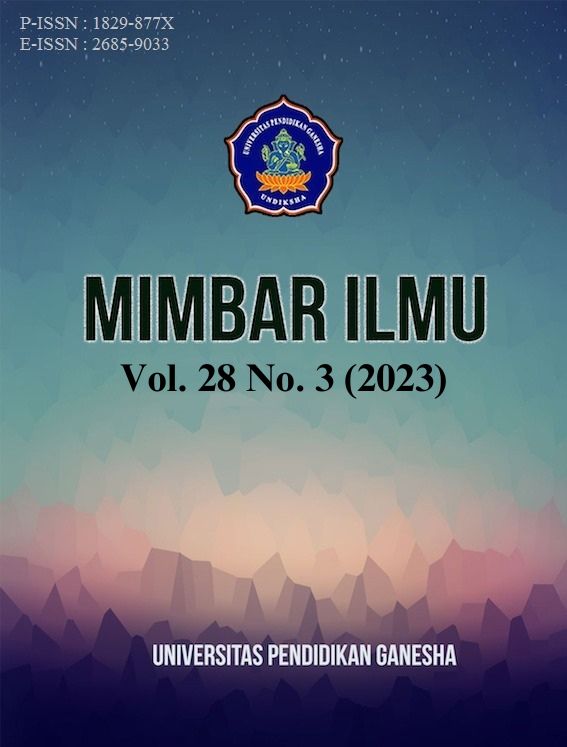Lexical Density and Readibility of Joe Biden’s Victory Speech
DOI:
https://doi.org/10.23887/mi.v28i3.68448Keywords:
Lexical Density, Legibility, Speech Performance, Joe BidenAbstract
This research focuses on the readability and lexical density of Joseph Robinette Biden Jr.'s speech, more commonly referred to as Joe Biden's victory speech. This research aims to analyze the verbal density and readability of Joe Biden's victory speech. This research uses a mixed quantitative and qualitative research design. The primary data source for this research is Joe Biden's speech to win the election. The data collection instrument uses a questionnaire. Data analysis techniques are qualitative and quantitative descriptive analysis. The research results were 852 content words and 990 grammar words. This text contains a lexical density of 46.2, which places it in the high verbal density classification. Beverly's theory, q (1988), states that the readability score is 64.23, which means that standard, there are 142 sentences, 1842 words, and 2833 syllables. The influence of his speech on lexical density and readability shows that he used words that listeners easily understood because they expressed a lot of gratitude and happiness. His speech also reflected Biden's character, who loves to praise, is full of hope, is brave, and is not fanatical. Hence, the American people admired people, which led him to become America's leader.
References
Bali, M., Cronin, C., & Jhangiani, R. S. (2020). Framing open educational practices from a social justice perspective. Journal of Interactive Media in Education, 2020(1), 1–12. https://doi.org/10.5334/jime.565. DOI: https://doi.org/10.5334/jime.565
Bryman, A. (2016). Social research methods (5th ed.). Oxford.
Buck, C., Keweloh, C., Bouras, A., & Simoes, E. J. (2021). Efficacy of short message service text messaging interventions for postoperative pain management: systematic review. JMIR MHealth and UHealth, 9(6), e20199. https://mhealth.jmir.org/2021/6/e20199. DOI: https://doi.org/10.2196/20199
Cole, E. R. (2018). College Presidents and Black Student Protests: A Historical Perspective on the Image of Racial Inclusion and the Reality of Exclusion. Peabody Journal of Education, 93(1), 78–89. https://doi.org/10.1080/0161956X.2017.1403180. DOI: https://doi.org/10.1080/0161956X.2017.1403180
Creswell, J., & Pioano Clark, V. (2007). Introducing a mixed method design. Designing and Conducting Mixed Methods Research, 58–89.
Cummins, C., Pellicano, E., & Crane, L. (2020). Autistic adults’ views of their communication skills and needs. International Journal of Language & Communication Disorders, 55(5), 678–689. https://doi.org/https://doi.org/10.1111/1460-6984.12552. DOI: https://doi.org/10.1111/1460-6984.12552
Dang, T. N. Y. (2018). The nature of vocabulary in academic speech of hard and soft-sciences. English for Specific Purposes, 51, 69–83. https://doi.org/https://doi.org/10.1016/j.esp.2018.03.004. DOI: https://doi.org/10.1016/j.esp.2018.03.004
Danvers, E. (2021). Individualised and instrumentalised? Critical thinking, students and the optics of possibility within neoliberal higher education. Critical Studies in Education, 62(5), 641–656. https://doi.org/10.1080/17508487.2019.1592003. DOI: https://doi.org/10.1080/17508487.2019.1592003
Dementyev, V. (2016). Speech Genres and Discourse: Genres Study in Discourse Analysis Paradigm. Russian Journal of Linguistics, 20(4), 103–121. https://doi.org/10.22363/231229182220166200441033121. DOI: https://doi.org/10.22363/2312-9182-2016-20-4-103-121
Desnita, Festiyed, Marsa, P. B., Novisya, D., & Hamida, S. (2021). Development of instruments to measuring feasibility of context-based videos of sound. In Journal of Physics: Conference Series (Vol. 1816, Issue 1). https://doi.org/10.1088/1742-6596/1816/1/012033. DOI: https://doi.org/10.1088/1742-6596/1816/1/012033
Dunbar, N. E., Brooks, C. F., & Kubicka-Miller, T. (2006). Oral communication skills in higher education: Using a performance-based evaluation rubric to assess communication skills. Innovative Higher Education, 31(2), 115–128. https://doi.org/10.1007/s10755-006-9012-x. DOI: https://doi.org/10.1007/s10755-006-9012-x
Durbahn, M., Rodgers, M., & Peters, E. (2020). The relationship between vocabulary and viewing comprehension. System, 88, 102166. https://doi.org/https://doi.org/10.1016/j.system.2019.102166. DOI: https://doi.org/10.1016/j.system.2019.102166
Eom, M., & Papi, M. (2022). Interplay of a Learner’s Regulatory Focus and Genre on Second Language Writing. English Teaching(South Korea), 77(1), 41–66. https://doi.org/10.15858/ENGTEA.77.1.202203.41. DOI: https://doi.org/10.15858/engtea.77.1.202203.41
Ghazanfari, M., Mohtasham, N. H., & Amirsheibani, M. (2016). Genre Analysis of Nursing and ELT Academic Written Discourse. Journal of Language Teaching and Research, 7(5), 973–978. https://doi.org/10.17507/jltr.0705.19. DOI: https://doi.org/10.17507/jltr.0705.19
Gizatulina, D., Ismaeva, F., Solnyshkina, M., Martynova, E., & Yarmakeev, I. (2020). Fluctuations of text complexity: the case of Basic State Examination in English. SHS Web of Conferences, 88, 02001. https://doi.org/10.1051/shsconf/20208802001. DOI: https://doi.org/10.1051/shsconf/20208802001
Islamiyah, M., & Fajri, M. S. Al. (2019). Error Analysis and Its Implications for the English Classroom : A Case Study of an Advanced English Learner. Indonesian EFL Journal: Journal of ELT, Linguistics, and Literature, 5(2), 1–13. http://ejournal.kopertais4.or.id/mataraman/index.php/efi/article/view/3736.
Kuncoro, A., & Husnurrosyidah, H. (2015). Kualitas layanan short message service (sms) terhadap efektifitas komunikasi dilingkungan organisasi kemahasiswaan. EKSIS, X(1), 42–51. https://ejournal.undiksha.ac.id/index.php/JERE/article/view/34958. DOI: https://doi.org/10.26533/eksis.v10i1.53
Kusuma, W. I. M. A., Budasi, I. G., & Suarnajaya, I. W. (2020). Lexicons of Tabuh Rah Used in Menyali Village. Prasi, 15(2), 71. https://doi.org/10.23887/prasi.v15i02.26906. DOI: https://doi.org/10.23887/prasi.v15i02.26906
Liu, C. Y. (2023). Examining the implementation of academic vocabulary, lexical density, and speech rate features on OpenCourseWare and MOOC lectures. Interactive Learning Environments, 31(8), 4924–4939. https://doi.org/10.1080/10494820.2021.1987274. DOI: https://doi.org/10.1080/10494820.2021.1987274
Ma’yuuf, H. H., & Hasan, T. A.-R. (2021). A Semantic-Pragmatic Study of Understatement in Trump’s and Biden’s 2020 Presidential Debate. PalArch’s Journal of Archaeology of Egypt / Egyptology, 18(4), 2610–2619. https://archives.palarch.nl/index.php/jae/article/view/6689.
Made, I. A., Widiastuti, S., Gde, I., Agus Pramerta, P., Suparsa, I. N., & Sukanadi, N. L. (2020). Discourse In Diverse Assessment Techniques Employed By Language Teachers. International Journal of Linguistics and Discourse Analytics, 2(1). https://doi.org/10.52232/ijolida.v2i1.32. DOI: https://doi.org/10.52232/ijolida.v2i1.32
Miles, M. B., Huberman, A. M., & Saldana, J. (2014). Qualitative Data Analysis. Sage Publication.
Nasseri, M., & Thompson, P. (2021). Lexical density and diversity in dissertation abstracts: Revisiting English L1 vs. L2 text differences. Assessing Writing, 47, 100511. https://doi.org/10.1016/j.asw.2020.100511. DOI: https://doi.org/10.1016/j.asw.2020.100511
Novedo, N., & Linuwih, E. R. (2018). Code Switching and Code Mixing Used By Sarah Sechan and Cinta Laura in Sarah Sechan Talk Show. Seminar Nasional Ilmu Terapan, 1(1), 1–8. https://ojs.widyakartika.ac.id/index.php/sniter/article/view/94.
Orchard, E. R., Ward, P. G., Sforazzini, F., Storey, E., Egan, G. F., & Jamadar, S. D. (2020). Relationship between parenthood and cortical thickness in late adulthood. PLoS One, 15(7), 236031. https://doi.org/10.1371/journal. DOI: https://doi.org/10.1371/journal.pone.0236031
Pawlak, M. (2013). Researching Grammar Learning Strategies: Combining The Macro-and Micro-Perspective. In Perspectives on Foreign Language Learning (pp. 193–211). Wydawnictwo Uniwersytetu Łódzkiego. DOI: https://doi.org/10.18778/7969-032-9.15
Strauß, A., Wu, T., McQueen, J. M., Scharenborg, O., & Hintz, F. (2022). The differential roles of lexical and sublexical processing during spoken-word recognition in clear and in noise. Cortex, 151, 70–88. https://doi.org/10.1016/j.cortex.2022.02.011. DOI: https://doi.org/10.1016/j.cortex.2022.02.011
Susoy, Z. (2023). Lexical Density, Lexical Diversity and Academic Vocabulary Use: Differences in Dissertation Abstracts. Acuity: Journal of English Language Pedagogy, Literature & Culture, 8(2). https://search.ebscohost.com/login.aspx?direct=true&profile=ehost&scope=site&authtype=crawler&jrnl=25410237&AN=173355275&h=AXpY1tyl3S%2BdzCnLu1fjUnz38d0PQJcPT4fCdu6j9EBcQYXfChc%2Bo8FNQSQhrmBWOoirWLPytmOPHZmyZ2nmmQ%3D%3D&crl=c.
Wahyuningsih, W., & Nirmala, D. (2020). Perlocutionary Act of Euphemism in Indonesian Presidential Election Debate 2019. Indonesian Journal of EFL and Linguistics, 5(1), 113. https://doi.org/10.21462/ijefl.v5i1.230. DOI: https://doi.org/10.21462/ijefl.v5i1.230
Yayuk, R. (2018). Leksikon Pengungkap Karakteristik Budaya Sungai Masyarakat Banjarmasin Dan Nagara: Telaah Etnosemantis (Lexicon of Characteristic Disclosure of River Culture At Banjarmasin and Nagara Societies: an Ethnosemantic Study. Naditira Widya, 12(2), 131. https://doi.org/10.24832/nw.v12i2.312. DOI: https://doi.org/10.24832/nw.v12i2.312
Ziashahabi, S., Jabbari, A. A., & Razmi, M. H. (2020). The effect of interventionist instructions of English conversational implicatures on Iranian EFL intermediate level Learners’ pragmatic competence development. Cogent Education, 7(1), 1–20. https://doi.org/10.1080/2331186X.2020.1840008. DOI: https://doi.org/10.1080/2331186X.2020.1840008
Downloads
Published
How to Cite
Issue
Section
License
Copyright (c) 2023 Sonya Sibagariang

This work is licensed under a Creative Commons Attribution-ShareAlike 4.0 International License.
This work is licensed under a Creative Commons Attribution-ShareAlike 4.0 International License.
Authors who publish with this journal agree to the following terms:
- Authors retain copyright and grant the journal right of first publication with the work simultaneously licensed under a Creative Commons Attribution-ShareAlike 4.0 International License that allows others to share the work with an acknowledgment of the work's authorship and initial publication in this journal.
- Authors are able to enter into separate, additional contractual arrangements for the non-exclusive distribution of the journal's published version of the work (e.g., post it to an institutional repository or publish it in a book), with an acknowledgment of its initial publication in this journal.
- Authors are permitted and encouraged to post their work online (e.g., in institutional repositories or on their website) prior to and during the submission process, as it can lead to productive exchanges, as well as earlier and greater citation of published work.





